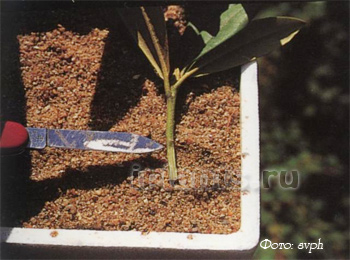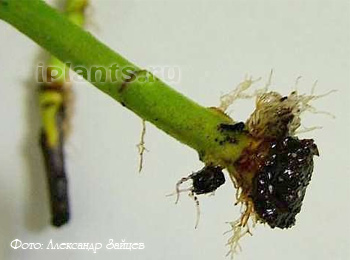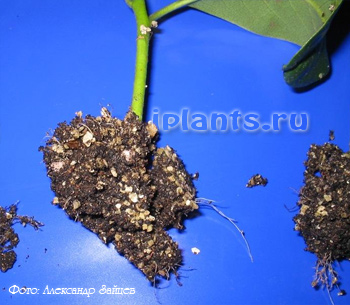 If you cover the azalea stalk with a jar, but little and rarely ventilate, the stalk rots in the damp ground, black spots appear on the lower leaves, and then they fall off.
If you cover the azalea stalk with a jar, but little and rarely ventilate, the stalk rots in the damp ground, black spots appear on the lower leaves, and then they fall off.If azaleas and rhododendrons took root so easily, once or twice, this theme would exist. But rooting azaleas is no easy matter. Therefore, we collect the experience of flower growers who managed to conquer this beautiful flower and even learned to multiply it.
Svetlana Larsen (svph) shares her experience gained from her own mistakes. I give it verbatim so as not to miss a grain of important information:
So, there is one secret in the cuttings of rhododendrons, which for some reason is very rarely mentioned in the literature. Maybe because so far only specialists are engaged in this. A girl from Riga told me about these features, who wrote a diploma on cutting wild and varietal rhododendrons, and then an American at an international flower forum. The approach is somewhat different, but the meaning is the same.
But first about the basics, without which nothing will work. My rhododendrons only took root on the third attempt. Therefore, it is so important to observe all the little things .
Root in peat. This was put on stream at the University of Riga. Peat was taken directly from the swamp, riding. But there was mass production. It makes sense for you to buy land for azaleas. In fact, it is already with the addition of fertilizers. And it would be better to clean peat. The point is that the soil is light.
The American is rooted in vermiculite. He says that it is possible in the sand. But I chose peat. It is also advisable to check its acidity. The lower the better. I did not anneal or water with any fungicides.

And now about the cuttings. The fact that they must be ripe is an axiom. This is checked at a break. If the cutting in the middle breaks with the characteristic sound of breaking wood, then it is ready for cutting. The vegetative point of the handle should finish its development, i.e. there should be a well-formed kidney, and all leaves should be of normal size. It is not necessary, vegetative kidney, maybe flower. If it is floral, then it will disappear itself. Everyone gives the size of the cutting 10-15 cm, but I tried not to cut too much, and last year I got 20-centimeter cuttings.
At the bottom, the slice can be either oblique or straight. This does not play a role. On the handle, it is necessary to make an oblique incision 1.5-2 cm long and such a width that the cut part of the bark is about one quarter of the remaining. I attach a drawing and a photo from the book. In the photo, if you look closely, you can see how the handle should look after the "operation." Without this incision and removal of part of the bark, the idea is doomed to failure. Callus, and then roots, are formed precisely on the lateral sections of the bark, and not on the lower section, as we used to count. Cutting, you need to try not to damage the forehead.
Then we dunk the handle into the stimulant. The American advises the strongest stimulant (for hard-to-root plants), while Riga is the opposite. She says the best result came with the weakest stimulant. So choose for yourself. I have a weak stimulant: for begonia, fuchsia, etc., which itself takes root without any stimulant. It was just that there was no other in the store. If the stimulator is liquid, then the handle must be kept in it for 14-17 hours and then planted.
I plant by eye. In the book, it is recommended to deepen by 2.5-3 cm. But if the handle was long, then I planted deeper. It is good to compress the soil around and cover with film. And be patient. Cuttings of large-leaved evergreen rhododendrons take 4 months to root, and then sit for a couple of months before they begin to grow. The film can only be removed when the cuttings have started to grow. Another such nuance. A box with cuttings should stand in the warmest and brightest place of the apartment. Cuttings take root at a temperature of at least + 22 ° С. In general, it is advisable to heat the bottom of the box. There, the desired temperature is + 25-27 ° C. Once a week, the box must be twisted with the other side to the window so that the cuttings are evenly lit. You can cut from mid-July to mid-October.
Also such information: the stalk does not have to be freshly cut. It can dry out for two or three days, and stand in a jar of water for two weeks. If it dries, then you must first put it in water. Of course, this will not add vitality to him, but it will not deprive him of the chance to take root. I know that we do not always have the opportunity to immediately plant everything in cans and pots. We get cuttings on occasion and always worry about how they will endure transportation, shrinkage and dressings. Therefore, such information is very useful. Although rhododendrons take root with such difficulty, they do not wither forever in a couple of hours.
I rooted azaleas twice (Knapp Hills). But of all the entrenched cuttings, only one survived. Azaleas have one bad feature - rooted cuttings must be forced to grow in the year of rooting. And this is very, very difficult - after all, they are cut in August, they take root for two or three months and it turns out that they should start growing in December-January. Well, what kind of lighting and what temperature in winter is not for me to tell you. That is, you need special lighting, additional heating while maintaining sufficient humidity. And if they sit rooted, but not sprouted until spring, then by next autumn they will disappear. Or they will last a year, and then they will disappear. But there is no year for year - sometimes almost all cuttings take root, and sometimes 95% disappear. And no stimulant fungicides help.
Rooting of deciduous azaleas
There is a slight difference in this case. In deciduous azaleas, this year's growth is taken for cuttings, which has not yet completed its development: the vegetative kidney must continue to grow, the upper leaves must be small, light green, that is, developing. If the top has finished its development, the leaves have acquired a dark green color and normal size, then such a handle will not take root. Therefore, in deciduous azaleas, cuttings are limited in time. This must be done somewhere within two weeks. I cannot say more specific terms. I have it late June - early July.
Another professional experience, Alexander Zaitsev (Alex):
A year ago, I tried to root several cuttings of Jacksony's evergreen rhododendron - none took root, after a few months I threw out the blackened ones. A new batch of cuttings is taking root this year. I root the cuttings in mini-tiles based on the principle of citrus fruits made from plastic bottles.
But he equipped the greenhouse - he placed another knee from a plastic bottle in the middle part, because the height of the cuttings is too high. Antiseptics - moss sphagnum and crushed birch coal - were added to the soil mixture from decay. Greenhouses are on the shelf. In connection with the decrease in the longitude of the day, I make additional illumination, this is followed by a timer and the simplest electronic device. The shelf is heated by lamps installed to illuminate the lower tier and the temperature inside the greenhouses is about 25 degrees, at night it decreases, but at this time there is no photosynthesis and it is not necessary to maintain it too high. Two months have passed since the cuttings were rooted. For control, I opened one greenhouse: a good callus formed on all cuttings.
It's been three months... I must say right away: ten cuttings of Jackson's rhododendron were rooted, two of them turned black in a couple of weeks, the rest are alive. Rooted in three greenhouses in the mixture: "Azalea" + vermiculite 15, 30, 45%, I did not feel a significant difference in rooting in three different ratios of the mixture. Moss sphagnum was added to the mixture. I opened three greenhouses today - seven cuttings grew a good root system, left one cuttings for additional rooting. In two years I will wait for flowering, exactly the same as on the mother plant.





